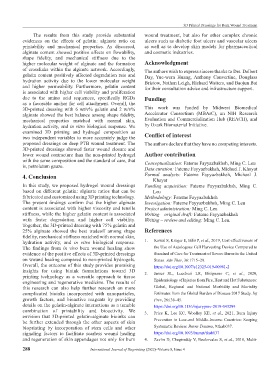Page 296 - IJB-8-4
P. 296
3D Printed Dressings for Burn Wound Treatment
The results from this study provide substantial wound treatment, but also for other complex chronic
evidences on the effects of gelatin: alginate ratio on ulcers such as diabetic foot ulcers and vascular ulcers
printability and mechanical properties. As discussed, as well as to develop skin models for pharmaceutical
alginate content showed positive effects on flowability, and cosmetic industries.
shape fidelity, and mechanical stiffness due to the
higher molecular weight of alginate and the formation Acknowledgment
of crosslinks within the alginate network. Accordingly, The authors wish to express sincere thanks to Drs. Delbert
gelatin content positively affected degradation rate and Day, Yue-wern Huang, Anthony Convertine, Douglass
hydration activity due to the lower molecular weight Bristow, Nathan Leigh, Richard Watters, and Baojun Bai
and higher permeability. Furthermore, gelatin content for their consultation advice and infrastructure support.
is associated with higher cell viability and proliferation
due to the amino acid sequences, specifically RGDs Funding
as a favorable anchor for cell attachment. Overall, the
3D-printed dressing with 6 wt/v% gelatin and 2 w/v% This work was funded by Midwest Biomedical
alginate showed the best balance among shape fidelity, Accelerator Consortium (MBArC), an NIH Research
mechanical properties matched with normal skin, Evaluation and Commercialization Hub (REACH), and
hydration activity, and in vitro biological response. We by Ozark Biomaterial Initiative.
examined 3D printing and hydrogel composition as Conflict of interest
two independent variables to more accurately judge the
proposed dressings on deep PTB wound treatment. The The authors declare that they have no competing interests.
3D-printed dressings showed faster wound closure and
lower wound contracture than the non-printed hydrogel Author contribution
with the same composition and the standard of care, that Conceptualization: Fateme Fayyazbakhsh, Ming C. Leu
is, petrolatum gauze. Data curation: Fateme Fayyazbakhsh, Michael J. Khayat
4. Conclusion Formal analysis: Fateme Fayyazbakhsh, Michael J.
Khayat
In this study, we proposed hydrogel wound dressings Funding acquisition: Fateme Fayyazbakhsh, Ming C.
based on different gelatin: alginate ratios that can be Leu
fabricated and customized using 3D printing technology. Methodology: Fateme Fayyazbakhsh
The present findings confirm that the higher alginate Investigation: Fateme Fayyazbakhsh, Ming C. Leu
content is associated with higher viscosity and tensile Project administration: Ming C. Leu
stiffness, while the higher gelatin content is associated Writing – original draft: Fateme Fayyazbakhsh
with faster degradation and higher cell viability. Writing – review and editing: Ming C. Leu.
Together, the 3D-printed dressing with 75% gelatin and
25% alginate showed the best tradeoff among shape References
fidelity, mechanical stiffness matched with normal skin,
hydration activity, and in vitro biological response. 1. Kowal S, Kruger E, Bilir P, et al., 2019, Cost-effectiveness of
The findings from in vivo burn wound healing show the Use of Autologous Cell Harvesting Device Compared to
evidence of the positive effects of 3D-printed dressings Standard of Care for Treatment of Severe Burns in the United
on wound healing compared to non-printed hydrogels. States. Adv Ther, 36:1715–29.
Overall, the outcome of this study provides promising https://doi.org/10.1007/s12325-019-00961-2
insights for using bioink formulations toward 3D 2. James SL, Lucchesi LR, Bisignano C, et al., 2020,
printing technology as a versatile approach to tissue
engineering and regenerative medicine. The results of Epidemiology of Injuries from Fire, Heat and Hot Substances:
this research can also help further research on more Global, Regional and National Morbidity and Mortality
complicated bioinks incorporated with nanoparticles, Estimates from the Global Burden of Disease 2017 Study. Inj
growth factors, and bioactive reagents by providing Prev, 26:i36–45.
details on the gelatin-alginate interactions as a tunable https://doi.org/10.1136/injuryprev-2019-043299
combination of printability and bioactivity. We 3. Price K, Lee KC, Woolley KE, et al., 2021, Burn Injury
envision that 3D-printed gelatin-alginate bioinks can Prevention in Low-and Middle-Income Countries: Scoping
be further extended through the other aspects of skin
bioprinting by incorporation of stem cells and other Systematic Review. Burns Trauma, 9:tkab037.
signaling factors to facilitate scarless wound healing https://doi.org/10.1093/burnst/tkab037
and regeneration of skin appendages not only for burn 4. Zavlin D, Chegireddy V, Boukovalas S, et al., 2018, Multi-
288 International Journal of Bioprinting (2022)–Volume 8, Issue 4

